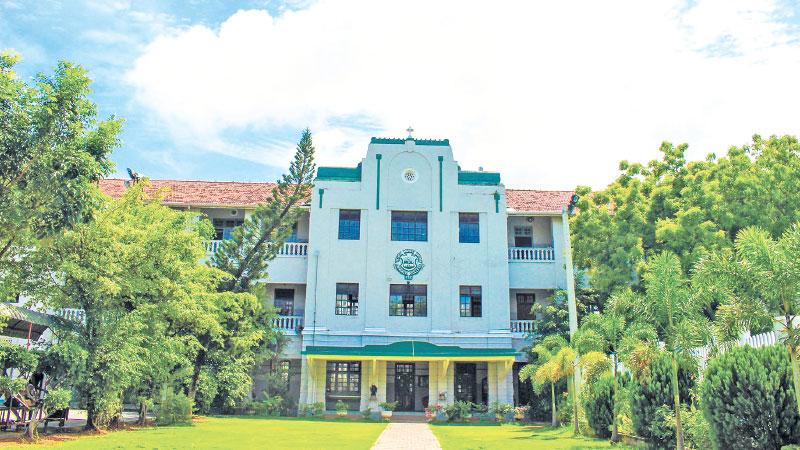
St. Benedict’s College, the oldest Catholic school in Colombo, has experienced administrative decay on and off during the past half century, but it now faces a crisis. The Catholic hierarchy in Sri Lanka must step in and revive the College, or let this venerable institution be destroyed.
The appellation St. Benedict’s stems from the Sylvestro-Benedictine monks, who in 1865 named the school after their patron. But, the origins of St. Benedict’s extend to 1839 when the Roman Catholic Seminary was set up at Wolfendhal Street. This genesis makes the school the second oldest in Sri Lanka (and only four years behind Royal College, which in turn began as the Hill Street Academy and was not christened with its present name until 1881- sixteen years after St. Benedict’s began to be so called). Thus St. Benedict’s celebrated its official sesquicentennial in 2015, when it was actually 176 years old!
The Lasallian Brothers took over the College in 1868 and this year marks the sesquicentennial of their administration. While scores of foreign and local Brothers have performed yeoman and heroic service on behalf of the school during the past 150 years, it is in the interest of St. Benedict’s and the Catholic Church that their superintendence extends no further.
A personal note is in order here, lest readers think this is an unwarranted attack on the Brothers. My family (granduncles, father, uncles, cousins, and nephews) and I are not just products of St. Benedict’s; we have also unfailingly supported the Lasallian Brothers. Indeed, when, in 2005, I edited Benedictine Memoirs, a volume that documents the College and life experience of 140 Old Bens, I dedicated it to the Lasallian Brothers. But by the time I wrote an essay about the future of St. Benedict’s for the school’s Sesquicentennial Souvenir, I had reached the conclusion that my College was in dire need of a different set of administrators and suggested discreetly that the Catholic priests were the most viable and best alternative.
It was not easy for me to say that in the essay, but the Brothers’ continued administration of the College will only exacerbate the decay facing St. Benedict’s. Indeed, many Old Bens believe the College is now run less in the interest of its students. This is why nearly every lay member of the St. Benedict’s College Old Boys’ Union Council of Management, the apex body of the College, requested that the school be turned over to the Catholic Fathers. And it is why some 80% of alumni who attended the first ever Special General Meeting of the Old Boys’ Union membership in August voted to do so as well.
Under the recent administrators of St. Benedict’s educational standards have been weakened and the College now has the least impressive GCE (O/L),GCE (A/L) and Grade 5 Scholarship results among leading Catholic schools; sports programs (especially athletics) that were among the best in the island have been crippled; a boarding that used to host close to 150 students now houses just five students; a Management Advisory Board instituted by concerned old boys to implement reforms has gone nowhere, and over 30 classrooms that Old Bens spent millions building during the past decade have been left disused. These are classrooms that could be educating 1,000 students, almost equivalent to an entire school; instead they lie dilapidated.
Loyal Old Bens who have tried to deal with the Welfare Society’s intimidation have hitherto reacted with commendable restraint; but their patience is running thin. This is all the more reason for the Catholic hierarchy to deal with the goings on at St. Benedict’s expeditiously and radically.
These same Brothers now ask for two years to set things right. This is like applying sticking plaster to cover a gaping and bleeding wound; because fixing the decay at St. Benedict’s will take more than two years and demands capabilities. If my academic background has taught me anything, it is that institutions take a long time to be built but are easily wrecked. What St. Benedict’s needs is radical surgery in the form of a permanent solution. And that solution is turning over the school to the Catholic Fathers.
Numerous are the Old Bens who have served non-Lasallian schools as Principals. These include Very Rev Fr Peter Pillai, the first Rector of St. Joseph’s College and Founder Rector of Aquinas University; Very Rev Fr D.J. Nicholas Perera, first Rector of St. Peter’s College; Very Rev Fr Mervyn Weerakkody, Rector at both St. Peter’s and St. Joseph’s; Rev Fr Felician Perera and Rev Fr Trevor Martin, Rectors at St. Peter’s; Rev Bro Paul Nizier, the great Marist Principal and Provincial; Rev Fr Paul Caspersz SJ, Rector at St. Aloysius College, Galle; and Rev J. A. Selvaratnam, Warden of S. Thomas’ College, Mount Lavinia. And in that tradition, many are the Old Ben priests with excellent credentials in today’s Church who are well suited to lead St. Benedict’s.
Additionally, numerous Old Bens are benefactors of the Catholic Church in Sri Lanka, and the school also has about a dozen alumni associations abroad that have consistently contributed funds towards developing the College. These individuals and entities are eager to work towards reviving St. Benedict’s but will only do so if they have confidence in the administrators.
There is much that needs to be done to revive St. Benedict’s College, and this includes getting rid of the miscreant in support bodies who are undermining the school, rewriting the constitutions of these support bodies so that grasping individuals with ulterior motives would never again control the affairs of the College, and transforming the current apathetic College culture to a dynamic and thriving culture befitting its history and legacy. We Benedictines can only achieve all this if we persuade the Catholic hierarchy to take over the school. Otherwise, Colombo’s oldest Catholic educational institution will wallow in mediocrity and, ultimately, be destroyed.
(The writer, an alumnus of St. Benedict’s College, is Professor of Politics and International Affairs at Wake Forest University, USA.)
